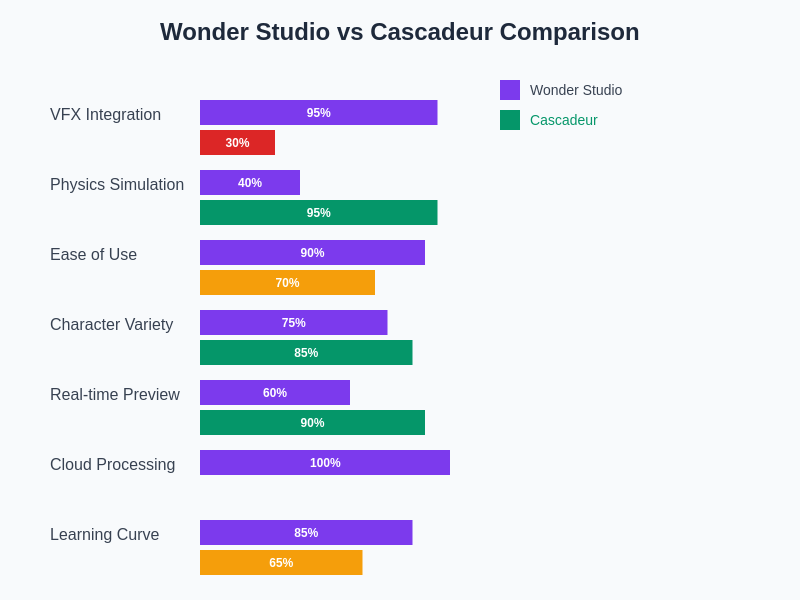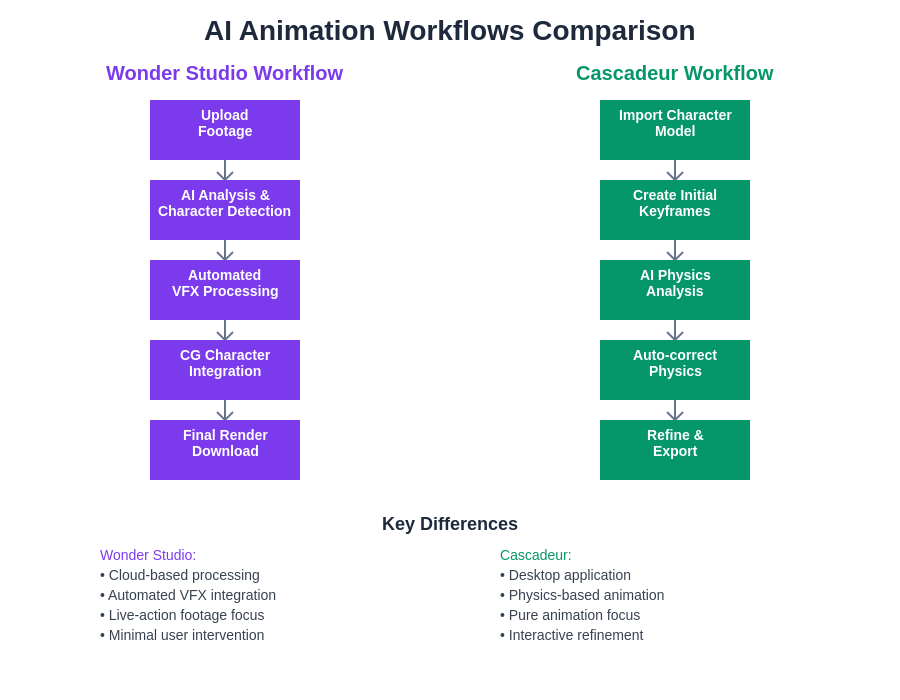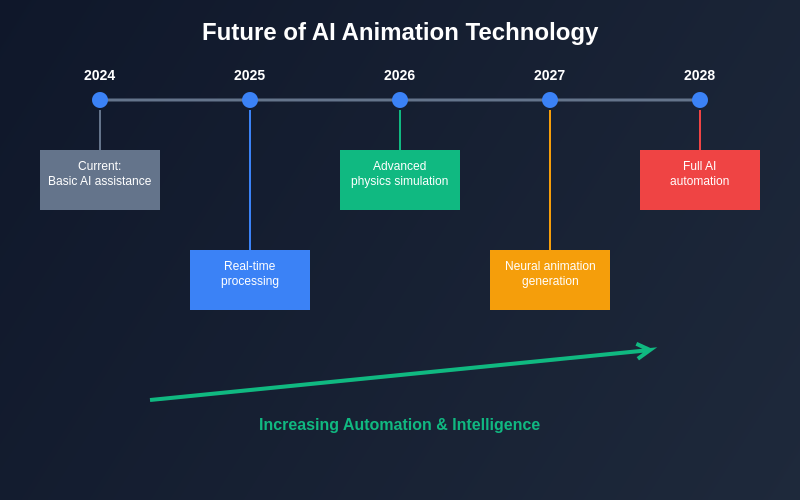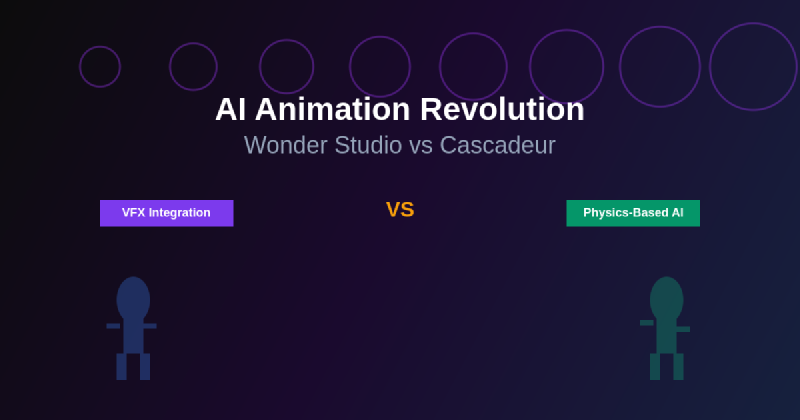The animation industry stands at the precipice of a technological revolution, where artificial intelligence has begun to fundamentally transform how character animation is conceived, created, and executed. Two groundbreaking platforms have emerged as leaders in this transformation: Wonder Studio, with its revolutionary approach to automated VFX and CG character integration, and Cascadeur, which has redefined physics-based character animation through intelligent AI assistance. This comprehensive analysis explores how these innovative tools are reshaping the landscape of digital character animation and what their emergence means for creators, studios, and the future of animated content.
Explore the latest AI animation trends to discover cutting-edge techniques and emerging technologies that are revolutionizing creative workflows across the entertainment industry. The convergence of artificial intelligence with traditional animation methodologies represents not merely an evolution of existing tools, but a complete paradigm shift that democratizes high-quality character animation while simultaneously pushing the boundaries of what creative professionals can achieve.
Wonder Studio: Revolutionizing VFX Character Integration
Wonder Studio represents a quantum leap in automated visual effects and character animation, fundamentally reimagining how CG characters can be seamlessly integrated into live-action footage. This cloud-based platform leverages sophisticated AI algorithms to automatically detect actors, track their movements, and replace them with fully animated CG characters while maintaining perfect lighting, camera movement synchronization, and environmental interaction. The technology eliminates the need for expensive motion capture equipment, specialized studios, and extensive manual compositing work that has traditionally made high-quality character animation accessible only to major studios with substantial budgets.
The platform’s revolutionary approach to character animation stems from its ability to automatically analyze live-action footage and extract detailed performance data, including body movement, facial expressions, and environmental lighting conditions. Wonder Studio then applies this extracted data to drive CG character animation, automatically handling complex tasks such as rotoscoping, motion tracking, and lighting match-moving that would typically require teams of specialized artists working for weeks or months. This automation extends to camera tracking and scene reconstruction, enabling the AI to understand three-dimensional space and ensure that animated characters interact naturally with their environments.
Wonder Studio’s impact on the animation industry extends far beyond technical capabilities, fundamentally altering the economics of character animation production. Independent filmmakers, small studios, and content creators can now achieve Hollywood-level visual effects without the prohibitive costs traditionally associated with professional character animation. The platform democratizes access to sophisticated animation tools while maintaining the quality standards expected by modern audiences, effectively removing barriers that have historically separated amateur and professional animation production.
Cascadeur: Physics-Based Animation Intelligence
Cascadeur approaches character animation from an entirely different perspective, focusing on the fundamental physics and biomechanics that govern realistic character movement. This innovative platform combines traditional keyframe animation techniques with advanced AI assistance that understands the physical principles underlying natural motion, enabling animators to create convincing character performances that respect the laws of physics while maintaining artistic control over creative expression.
The software’s revolutionary AutoPhysics system analyzes character poses and movements to ensure that animations adhere to realistic physical constraints, automatically adjusting trajectories, momentum, and force distribution to create believable motion sequences. This physics-aware approach eliminates the common issues that plague traditional animation, such as characters that appear to float, movements that violate conservation of momentum, or actions that seem disconnected from the forces that would naturally govern such motions in the real world.
Experience advanced AI animation tools like Claude for comprehensive creative assistance that enhances your animation workflow with intelligent suggestions and technical expertise. Cascadeur’s unique strength lies in its ability to serve both novice animators who benefit from automated physics correction and experienced professionals who can leverage the AI assistance to speed up their workflow while maintaining complete creative control over the final animation.
The platform’s approach to character animation education represents another significant advantage, as the physics-based feedback helps animators understand the fundamental principles that make movement appear natural and convincing. This educational aspect transforms Cascadeur from merely a production tool into a learning platform that improves animators’ understanding of movement, weight, and physical interaction in three-dimensional space.
Comparative Analysis: Workflow Integration and Use Cases
The fundamental difference between Wonder Studio and Cascadeur lies in their respective approaches to solving character animation challenges. Wonder Studio excels in scenarios where live-action footage needs to be enhanced or modified with CG characters, making it particularly valuable for filmmakers working on projects that combine real actors with animated characters, or content creators who want to replace human performers with fantastical or stylized animated characters while maintaining photorealistic integration.
Cascadeur’s strength emerges in pure animation contexts where characters need to perform complex physical actions such as combat sequences, acrobatic movements, or intricate dance choreography. The software’s physics-based approach makes it particularly valuable for game development, where character animations must seamlessly loop and transition between different movement states while maintaining consistent physical believability across various scenarios and environmental conditions.
The integration workflows for these platforms reflect their different philosophical approaches to animation production. Wonder Studio operates primarily as a cloud-based service that processes uploaded footage and returns fully composited sequences, making it ideal for projects with straightforward character replacement needs but potentially limiting for productions requiring extensive iterative refinement or complex character interaction scenarios.
Cascadeur functions as a traditional desktop application that integrates into existing animation pipelines, allowing for detailed customization and iterative refinement while providing AI assistance that enhances rather than replaces traditional animation techniques. This approach makes it more suitable for complex animation projects that require multiple revision cycles and detailed artistic control over character performance nuances.
Technical Capabilities and Limitations
Wonder Studio’s technical architecture relies heavily on cloud computing resources to process complex AI algorithms that analyze footage, extract performance data, and generate completed animation sequences. This cloud-based approach enables the platform to leverage powerful computing resources without requiring users to invest in expensive hardware, but it also introduces dependencies on internet connectivity and raises considerations about data security and project confidentiality for sensitive productions.
The platform’s current limitations include restrictions on character types and animation styles, with optimal results achieved when working with humanoid characters in well-lit environments with clear actor visibility. Complex scenarios involving multiple characters, extreme lighting conditions, or unconventional character designs may require additional manual refinement or may not be suitable for fully automated processing.
Cascadeur’s technical approach focuses on real-time physics simulation and biomechanical analysis that operates directly on the user’s hardware, providing immediate feedback and enabling interactive refinement of animation sequences. This approach offers greater creative control and flexibility but requires more substantial hardware resources and technical expertise from users who want to fully leverage the platform’s capabilities.
The software’s limitations primarily relate to its focus on realistic physics-based animation, which may not be suitable for stylized or exaggerated animation styles that intentionally violate physical laws for artistic effect. Additionally, while the AI assistance significantly improves animation quality and workflow efficiency, it still requires fundamental animation knowledge and skills from users to achieve professional-level results.

The evolving landscape of AI-powered animation tools demonstrates distinct advantages and applications for different creative workflows. While both Wonder Studio and Cascadeur leverage artificial intelligence to enhance animation production, their approaches serve complementary roles in the broader ecosystem of digital content creation.
Production Pipeline Integration
The integration of AI animation tools into existing production pipelines requires careful consideration of workflow compatibility, asset management, and quality control processes. Wonder Studio’s cloud-based architecture makes it particularly well-suited for productions that can accommodate its automated processing approach, but may require pipeline adjustments for studios accustomed to maintaining complete control over every aspect of the animation process.
Traditional VFX pipelines often involve multiple specialized departments handling different aspects of character integration, from rotoscoping and tracking to lighting and compositing. Wonder Studio consolidates many of these functions into a single automated process, which can significantly streamline production timelines but may require restructuring of team responsibilities and quality assurance procedures.
Cascadeur’s integration approach aligns more closely with traditional animation pipelines, functioning as an enhanced animation tool that can export standard animation data to other software packages. This compatibility makes it easier to incorporate into existing workflows while providing AI assistance that enhances rather than replaces established production methodologies.
The platform’s ability to export physics-corrected animations to industry-standard formats ensures compatibility with game engines, rendering systems, and other animation software, making it a valuable addition to multi-software production pipelines rather than a replacement for existing tools.
Enhance your research and development with Perplexity to stay current with rapidly evolving AI animation technologies and industry best practices. The continuous advancement of AI animation tools requires ongoing education and experimentation to fully leverage their capabilities within professional production environments.
Cost-Effectiveness and Accessibility
The economic impact of AI animation tools extends beyond simple cost reduction, fundamentally altering the business models and accessibility of high-quality character animation. Wonder Studio’s subscription-based pricing model makes professional-level VFX capabilities accessible to independent creators and small studios that previously could not afford the equipment, software, and specialized personnel required for comparable results.
This democratization effect has significant implications for content diversity and creative expression, enabling storytellers from diverse backgrounds and economic circumstances to produce visually sophisticated content that can compete with traditionally well-funded productions. The platform’s automated approach reduces the need for extensive technical training while still producing results that meet professional quality standards.
Cascadeur’s approach to accessibility focuses on reducing the skill barrier for creating convincing character animation while maintaining affordability for independent developers and small animation studios. The software’s physics-based AI assistance helps less experienced animators avoid common mistakes while providing advanced tools that experienced professionals can use to enhance their productivity and creative capabilities.
The educational value provided by both platforms represents an additional form of accessibility, as users naturally develop better understanding of animation principles through interaction with AI systems that embody best practices and technical expertise developed by industry professionals.
Quality Standards and Professional Applications
Professional animation quality encompasses multiple dimensions including technical accuracy, artistic expression, and production efficiency. Wonder Studio excels in technical accuracy for character integration, automatically handling complex compositing tasks that require significant expertise when performed manually. The platform’s AI algorithms have been trained on professional-quality examples, enabling it to achieve results that meet broadcast and theatrical standards for many types of character integration scenarios.
However, the platform’s automated approach may limit artistic expression in scenarios requiring subtle performance nuances or unconventional creative choices that deviate from the training data patterns. Professional productions often require the ability to make creative decisions that prioritize artistic vision over technical perfection, which may necessitate additional manual refinement of Wonder Studio’s automated output.
Cascadeur’s approach to quality focuses on providing AI assistance that enhances artistic decision-making rather than replacing it, enabling animators to achieve higher quality results while maintaining complete creative control. The platform’s physics-based corrections improve technical accuracy without constraining artistic expression, making it suitable for productions that require both realistic movement and creative stylization.
The software’s educational feedback helps animators understand why certain adjustments improve animation quality, fostering skill development that benefits future projects beyond the immediate AI assistance provided by the platform.

The distinct workflow approaches of Wonder Studio and Cascadeur reflect different philosophies about the role of artificial intelligence in creative production. Understanding these differences enables creators to select the most appropriate tool for their specific project requirements and creative objectives.
Industry Impact and Future Implications
The emergence of AI-powered animation tools represents a fundamental shift in how the animation industry approaches talent development, project planning, and creative collaboration. Wonder Studio’s automation of complex VFX tasks reduces the demand for certain specialized technical skills while creating new opportunities for creators who can effectively integrate AI tools into their storytelling processes.
This technological shift parallels historical transformations in the animation industry, from the introduction of computer graphics to the development of motion capture technology, each of which initially displaced certain traditional skills while creating new opportunities and raising overall industry standards for visual quality and production efficiency.
Cascadeur’s impact on animation education and skill development suggests a future where AI assistance becomes an integral part of animation training, helping new animators understand fundamental principles while providing experienced professionals with tools that enhance their creative capabilities rather than replacing their expertise.
The platform’s physics-based approach also suggests potential applications beyond traditional animation, including applications in robotics, biomechanical research, and virtual reality development where realistic character movement is essential for user experience and technical functionality.
Creative Possibilities and Artistic Expression
The creative possibilities enabled by AI animation tools extend far beyond simple efficiency improvements, opening new avenues for artistic expression and storytelling that were previously impractical or impossible. Wonder Studio’s ability to seamlessly integrate CG characters into live-action footage enables filmmakers to explore hybrid storytelling approaches that blend reality with fantasy in ways that feel natural and convincing to audiences.
This capability has particular significance for genres such as science fiction, fantasy, and horror, where the believable integration of non-human characters is essential for audience immersion. The platform’s automated approach makes these genre productions accessible to creators without extensive VFX budgets while maintaining the visual quality necessary for effective storytelling.
Cascadeur’s physics-based animation capabilities enable the creation of action sequences and character performances that achieve new levels of realism and dynamic complexity. The AI assistance allows animators to explore more ambitious choreography and character interactions while ensuring that the resulting animations maintain physical believability that enhances rather than distracts from the narrative content.
The platform’s ability to handle complex physics interactions also enables the creation of environmental storytelling where character movements reveal information about weight, texture, and physical properties of objects and surfaces within the animated world.

The distinct workflow approaches of Wonder Studio and Cascadeur demonstrate how different AI animation philosophies address various creative and technical challenges. While Wonder Studio emphasizes automated processing and seamless integration, Cascadeur focuses on interactive refinement and physics-based accuracy.
Technical Evolution and Platform Development
The rapid evolution of AI animation technology suggests that both Wonder Studio and Cascadeur will continue to expand their capabilities and refine their approaches to character animation challenges. Wonder Studio’s cloud-based architecture enables continuous improvement of AI algorithms without requiring software updates from users, potentially leading to enhanced character recognition, improved lighting analysis, and expanded compatibility with different types of footage and character designs.
Future developments may include real-time processing capabilities, enhanced customization options, and integration with virtual production techniques that combine live-action filming with real-time character replacement and environmental enhancement.
Cascadeur’s development trajectory appears focused on expanding physics simulation capabilities, improving AI assistance accuracy, and enhancing integration with other animation and game development tools. Future versions may include advanced crowd simulation, environmental interaction modeling, and enhanced support for non-humanoid character animation.
The platform’s educational aspects may also evolve to include more sophisticated feedback systems, personalized learning recommendations, and integration with formal animation education programs that can leverage AI assistance to improve learning outcomes and skill development efficiency.

The trajectory of AI animation technology points toward increasingly sophisticated tools that enhance human creativity rather than replacing it. Both Wonder Studio and Cascadeur represent important steps in this evolution, demonstrating different approaches to leveraging artificial intelligence for character animation enhancement.
Conclusion: Choosing the Right AI Animation Tool
The selection between Wonder Studio and Cascadeur ultimately depends on specific project requirements, creative objectives, and production contexts rather than objective superiority of either platform. Wonder Studio excels in scenarios requiring seamless integration of CG characters into live-action footage, making it invaluable for filmmakers and content creators working on projects that combine real and animated elements.
Cascadeur’s strength lies in pure animation contexts where physics-based realism enhances storytelling and character performance, making it particularly valuable for game development, action sequences, and educational applications where movement accuracy is essential for user experience and narrative effectiveness.
Both platforms represent significant advances in AI-assisted animation, demonstrating how artificial intelligence can enhance human creativity rather than replace it. The future of character animation likely involves the integration of multiple AI tools that address different aspects of the animation pipeline, with creators selecting and combining technologies based on their specific creative vision and production requirements.
The continued development of AI animation tools promises to further democratize high-quality character animation while providing professional animators with increasingly sophisticated assistance that enhances their creative capabilities and production efficiency. This evolution benefits the entire creative industry by raising quality standards while reducing barriers to entry for diverse voices and innovative storytelling approaches.
Disclaimer
This article is for informational purposes only and does not constitute professional advice. The views expressed are based on current understanding of AI animation technologies and their applications in creative production. Readers should conduct their own research and consider their specific requirements when selecting animation tools and technologies. The effectiveness and suitability of AI animation platforms may vary depending on project requirements, technical expertise, and creative objectives.
